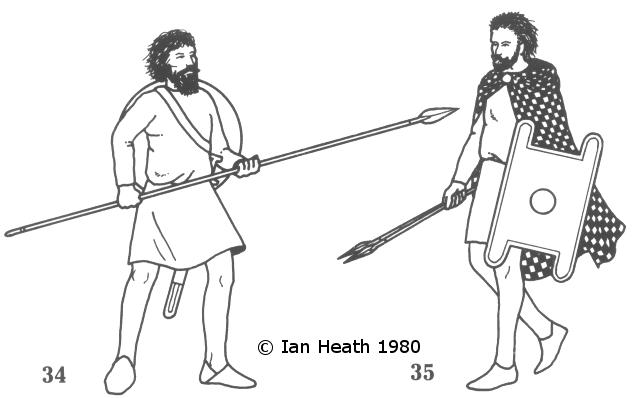
Create an Amazon Wedding Registry

| |
| [Based on Pictish Infantrymen on the Aberlemno Stone] | [Based on the Pictish Infantryman on the Saint Andrews Sarcophagus] |
PICTISH INFANTRYMEN
An extract from Armies of the Dark Ages 600-1066by Ian Heath


| |
| [Based on Pictish Infantrymen on the Aberlemno Stone] | [Based on the Pictish Infantryman on the Saint Andrews Sarcophagus] |
34 & 35. PICTISH INFANTRYMEN
34 is taken from the Aberlemno stones of c. 750, as are 31 and 32. He is armed with the usual longish thrusting spear, a short sword and a circular shield suspended at his back from a shoulder strap. Others would substitute a bow for the spear.
35 dates to the mid-10th century so is more accurately a 'Scot', though the inhabitants of Scotland were now a confusing mixture of Picts, Scotti, Strathclyde Welsh, Northumbrian Saxons and Scandinavians. He is armed with javelins and carries an unusual shield which, since it has a central boss, is probably of leather-covered wood rather than stretched hide; an identical shield is to be seen held by a foot-soldier on the Ardchattan Stone, which has been assigned to the 11th century. His rough woollen cloak is checkered in Pictish fashion. Tartan as we know it did not develop until much later than the period we are here concerned with, the word itself evolving from 'tiretain', of Anglo-French origin, meaning simply a brightly coloured woollen material. Other clothing appears to have been of the same coloration as that of the Irish described below, tunics usually being described as light or bright, occasionally with coloured borders or red embroidery.
Trews such as those of 39 could be worn in addition to the tunic, though Scots soldiers normally went barelegged. Others wore only a sleeveless shirt which could be buttoned or tied between the legs. Certainly in the mid-6th century Gildas laments the Picts' and Scots' lack of decent clothing, many Scots remaining ill-clad until centuries beyond the end of this era.